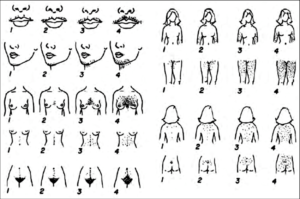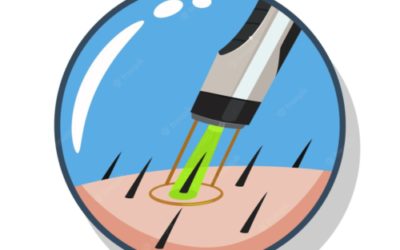
Hirsutism is defined as excess terminal hair that commonly appears in a male pattern in women.
Hirsutism is divided into androgen (male hormone)- and non-androgen-induced types.
Most frequent cause of hyperandrogenic hirsutism is polycystic ovarian syndrome (PCOS).
The most frequent cause of non-androgen-induced hirsutism is idiopathic (the cause is unknown) hirsutism.
Both idiopathic hirsutism and PCOS account for 95% of hirsutism.
Because increased androgen levels may also lead to pilosebaceous responses, such as acne, excessive sebum secretion, or diffuse or localized loss of hair, a dermatologic examination is mandatory.
The spectrum of hirsutism varies from mild to severe.
To quantify hirsutism, there are different methods are available for the assessment of hair growth in women.
Ferriman and Gallwey introduced a scoring system in 1961 incorporating eleven androgen dependent sites such as the lip, chin, chest, upper abdomen, lower abdomen, upper arm, forearm, thigh, lower leg, upper back, and lower back.
This scoring system evaluates eleven different body parts, with scores ranging from zero (no excessive terminal hair growth visible) to four (extensive hair growth visible) for each body part evaluated.
A maximum score of 36 is possible, but a score of ≥6- 8 typically indicates hirsutism, as defined by the 95th percentile of data initially collected by Ferriman.
While evaluating the hirsute patient, a thorough history must be taken, including information on the patient’s marital status, infertility, age at menarche, menstrual irregularities, presence of a deepening of the voice, increased muscle mass, androgen alopecia, galactorrhea, decreased breast size, emotional and mental state, and other disorders.
Ferriman-Gallwey score

Hirsutism causes psychological and social problems in women, so it is important to diagnose and treat. Family history is important; 50 percent of women with hirsutism have a positive family history of the disorder.
The Ferriman-Gallwey scoring system was found to be clinically useful. The feet, thighs, arms and chin were observed to have the highest score of androgen-sensitive area of the body.
The Ferriman-Gallwey scoring system has a great significance and value to establish the diagnosis of hirsutism and is an acceptable screening method.



